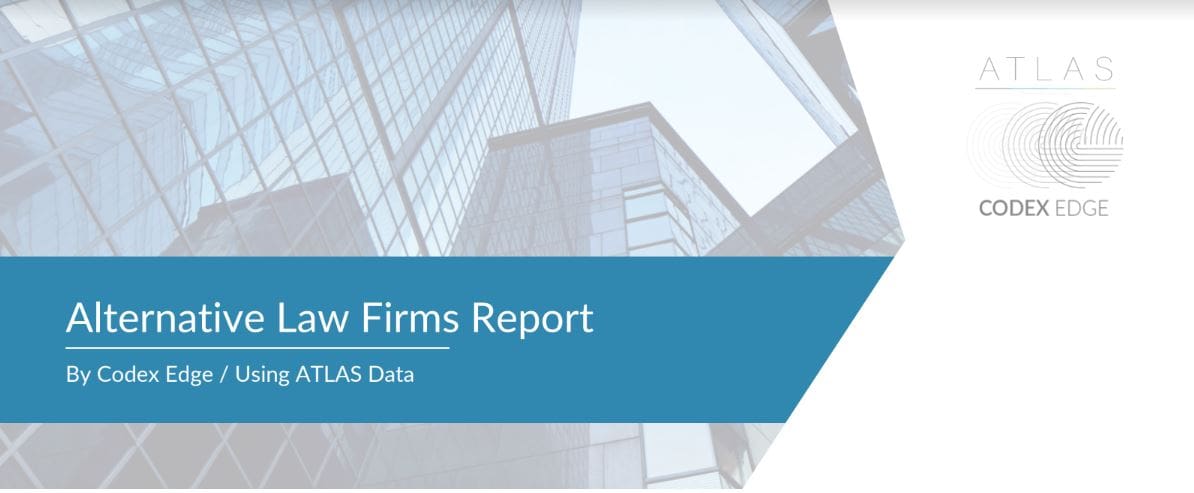As we reported recently, we are currently witnessing a sea change in the legal profession as more and more lawyers quit working at traditional law practices in favour of alternative law firms (ALFs) running a consultancy model.
Indeed, according to research recently published by Codex Edge in its Alternative Law Firms Report, this trend is so strong that up to one-quarter of lawyers could be working at ALFs within the next three years.
This is an astonishing statistic, and the report in general makes for such interesting reading that we thought it worth drilling into at a more granular level. Below, we, therefore, bring you some of the key stats from the ATLAS Report, together with our analysis of the figures.
The top firms and cities
All but one set of statistics (the retention figures) in the ATLAS report are based on consultant head count. According to this metric, the top five ALFs in order are Setfords, Keystone Law, Taylor Rose MW, Gunnercooke and Spencer West. Between them, the top 10 firms employ a total of 2,150 people, of whom just over half (1,099) are female. More on which, later.
Table 1: top ten firms by consultant head count, with gender distribution
| Setfords | 419 |
| Keystone Law | 405 |
| Taylor Rose MW | 353 |
| Gunnercooke | 296 |
| Spencer West | 115 |
| Excello Law | 110 |
| Nexa Law | 87 |
| Scott-Moncrieff & Associates | 33 |
| Bexley Beaumont | 33 |
| Saracens Solicitors | 30 |
| Other | 269 |
| Total | 2,150 |
| Gender | |
| Female | 1,091 |
| Male | 1,055 |
The first thing to note is that, although all of the top five firms started life in the South East and in London in particular, they now all have regional offices throughout the UK, and indeed extend beyond Britain’s shores to Europe and further abroad. This is a reflection of the flexibility afforded by the ALF model, which allows lawyers to work where and when suits them best.
Table 2: top ten cities by consultant head count, with gender distribution
| London | 1281 |
| Manchester | 121 |
| Peterborough | 99 |
| Leeds | 78 |
| Guildford | 37 |
| Birmingham | 34 |
| Liverpool | 25 |
| Bristol | 22 |
| Leicester | 20 |
| Nottingham | 17 |
| Other | 508 |
| Total | 2,242 |
| Gender | |
| Female | 1,091 |
| Male | 1,055 |
Given that London continues to be the economic powerhouse of the UK, it is unsurprising that the vast majority of consultants are still based there. However, it is interesting to note that the three next-biggest cities – Manchester, Peterborough and Leeds – are all north of Birmingham (or, in the case of Peterborough, at least slightly above parallel to Brum). Perhaps the legal industry is quietly implementing its own levelling-up agenda?
The top specialisms and their gender distribution
Residential property, commercial property, commercial litigation, corporate M&A and employment make up the top five legal specialisms. When we look at the gender distribution amongst the top firms in each of these specialist fields, an interesting picture emerges.
Table 3: top ten specialisms by consultant head count
| Residential property | 556 |
| Commercial property | 447 |
| Commercial litigation | 279 |
| Corporate M&A | 213 |
| Employment | 190 |
| Personal tax, trust and probate | 164 |
| Family | 162 |
| Commercial contracts | 138 |
| Corporate finance | 126 |
| Intellectual property | 124 |
| Other | 1,370 |
| Total | 3,769 |
Residential property, the top specialism by some margin (556 consultants vs 447 consultants in the second-biggest specialism, commercial law), is also one of the areas in which the number of female consultants (342) heavily outweighs the number of male consultants (241). That’s 101 more women than men, or 61% vs 38 %. And property as a whole (so both residential and commercial) accounts for over one quarter of all consultants (1,003 of a total 7,769).
Table 3: top six residential property firms by consultant head count, with gender distribution
| Taylor Rose MW | 218 |
| Setfords | 216 |
| Keystone Law | 23 |
| Gunnercooke | 20 |
| Spencer West | 17 |
| Saracens Solicitors | 17 |
| Total | 511 |
| Gender | ||
| Female | 342 | 62% |
| Male | 214 | 38% |
The other specialism in the top five with a similar predominance of women is employment law, with 118 women (62%) and 72 men (38%).
Table 4: top five employment firms by consultant head count, with gender distribution
| Keystone Law | 47 |
| Gunnercooke | 28 |
| Setfords | 24 |
| Excello Law | 16 |
| Taylor Rose MW | 15 |
| Total | 130 |
| Gender | ||
| Female | 118 | 62% |
| Male | 72 | 38% |
When we look at the tables below for the other three specialisms in the top five – commercial property (247 men / 200 women), commercial litigation (184 men / 95 women) and corporate M&A (141 men / 71 women) – we see that the picture is inverted, with men dominating in these areas.
Table 5: top five commercial property firms by consultant head count, with gender distribution
| Setfords | 118 |
| Taylor Rose MW | 89 |
| Gunnercooke | 71 |
| Keystone Law | 52 |
| Excello Law | 28 |
| Total | 358 |
| Gender | ||
| Female | 200 | 45% |
| Male | 247 | 55% |
Table 6: top five commercial litigation firms by consultant head count, with gender distribution
| Keystone Law | 61 |
| Taylor Rose MW | 33 |
| Setfords | 31 |
| Gunnercooke | 30 |
| Spencer West | 22 |
| Total | 177 |
| Gender | ||
| Female | 95 | 34% |
| Male | 184 | 66% |
Table 7: top five corporate M&A firms by consultant head count, with gender distribution
| Keystone Law | 58 |
| Gunnercooke | 48 |
| Excello Law | 25 |
| Spencer West | 18 |
| Nexa Law | 14 |
| Total | 163 |
| Gender | ||
| Female | 71 | 33% |
| Male | 141 | 67% |
Outside of the top five specialisms, we see that female consultants also heavily outweigh male consultants in the area of personal tax, trust and probate, with 102 women (62%) to 62 men (38%).
Table 8: top five personal tax, trust and probate firms by consultant head count, with gender distribution
| Setfords | 58 |
| Taylor Rose MW | 26 |
| Keystone Law | 18 |
| Nexa Law | 15 |
| Gunnercooke | 12 |
| Total | 129 |
| Gender | ||
| Female | 102 | 62% |
| Male | 62 | 38% |
The area in which male consultants most heavily outweigh their female counterparts is in corporate finance, which comes ninth in the top ten specialisms: 85 men (67%) compared to 41 women (33%).
Table 8: top six corporate finance firms by consultant head count, with gender distribution
| Keystone Law | 39 |
| Gunnercooke | 26 |
| Excello Law | 9 |
| Spencer West | 8 |
| Setfords | 7 |
| Nexa Law | 7 |
| Total | 96 |
| Gender | ||
| Female | 41 | 33% |
| Male | 85 | 67% |
And the most female-dominated specialism (and thus the area with the biggest gender discrepancy) is seventh in the top ten: family law, with 125 female consultants (77%) compared to 37 male consultants (23%).
Table 9: top five family firms by consultant head count, with gender distribution
| Setfords | 51 |
| Taylor Rose MW | 30 |
| Keystone Law | 19 |
| Spencer West | 10 |
| Gunnercooke | 8 |
| Total | 118 |
| Gender | ||
| Female | 125 | 77% |
| Male | 37 | 23% |
In the two specialisms not yet covered, we see a slight predominance of men in commercial contract law (75 men / 63 women) and near gender parity in intellectual property (64 women / 60 men).
Table 10: top five commercial contract firms by consultant head count, with gender distribution
| Keystone Law | 33 |
| Gunnercooke | 24 |
| Spencer West | 15 |
| Excello Law | 13 |
| Setfords | 11 |
| Total | 96 |
| Gender | ||
| Female | 63 | 46% |
| Male | 75 | 54% |
Table 11: top five intellectual property firms by consultant head count, with gender distribution
| Keystone Law | 35 |
| Brandsmiths | 18 |
| Gunnercooke | 16 |
| Law 365 | 9 |
| Spencer West | 7 |
| Total | 85 |
| Gender | ||
| Female | 64 | 52% |
| Male | 60 | 48% |
Retention rates
When we analyse the retention rates in ALFs compared to those of traditional law firms, we see that the difference in consultant turnover is nothing short of astonishing. Whereas the top five ALFs manage to hire far more people than they lose, three of the five most active traditional law firms are positively haemorrhaging people, with the number of those leaving far outweighing the number of new hires at Eversheds, DWF and CMS. Only the most active recruiter, Addleshaw Goddard, managed to hire more people than exited the firm during the same six-month period, while the fifth-most active recruiter, Shoosmiths, lost two more people than it hired.
Table 12: retention rates amongst the top six ALFs vs the six most active (for hiring) traditional law firms
| ALFs | Total Joiners Jan-July 22 | Total Leavers Jan-July 22 | Net growth |
| Setfords | 120 | 28 | 92 |
| Taylor Rose MW | 105 | 22 | 83 |
| Keystone Law | 60 | 22 | 38 |
| Gunnercooke | 46 | 8 | 38 |
| Spencer West | 40 | 8 | 32 |
| Nexa Law | 25 | 18 | 7 |
| Traditional firms | |||
| Addleshaw Goddard | 138 | 130 | 8 |
| Eversheds | 140 | 180 | -40 |
| DWF | 126 | 168 | -42 |
| CMS | 115 | 158 | -43 |
| Shoosmiths | 106 | 108 | 2 |
Some conclusions
Now that we’ve delved into the figures from the ATLAS Alternative Law Firms Report, we can see that:
1) Slightly more women than men work at ALFs (1,091 women and 1,055 men).
2) There are more men than women working in the specialisms of corporate finance, commercial property, commercial litigation, corporate M&A and contract law.
3) More women than men work in family law, residential property, personal tax, trust and probate, and intellectual property.
4) ALFs enjoy excellent consultant retention rates compared to traditional law firms.
“What comes across so strongly in the data and in this report is just how significant an impact the challenger firms have had – and continue to have – in the UK legal services market. The growth is extraordinary, almost to the point where the terms ‘Alternative’ or ‘Challenger’ are no longer necessarily appropriate, as they become an established part of the landscape. Looking at our own moves data we can see that the trend for lawyers to opt for the platform model in increasing numbers is continuing at pace.”
Chris Hume, CEO, Codex Edge
The report also highlights the fact ALFs are currently enjoying significantly higher organic growth than traditional law firms. Indeed, whereas the top five hiring ALFs have a compound annual growth rate (headcount) of 15%, the top five hiring traditional law firms are actually shrinking, with a figure of -1%. Based on these current growth rates, the report’s authors feel confident in predicting that up to a quarter of lawyers could be working at ALFs within the next 3 years.
From this and the above figures, it seems safe to conclude that more and more lawyers are discovering the advantages of working in ALFs, and then enjoying said advantages once they have made the move.
Women in particular seem to benefit from the flexibility afforded to lawyers working under the consultancy and fee-sharing model. This is not least reflected by the fact that, as of 5 July 2022, 64% of the consultant lawyers at Setfords – the biggest ALF by head count – are women. This is one of the highest female-to-male ratios in a UK top 100 Law Firm.






